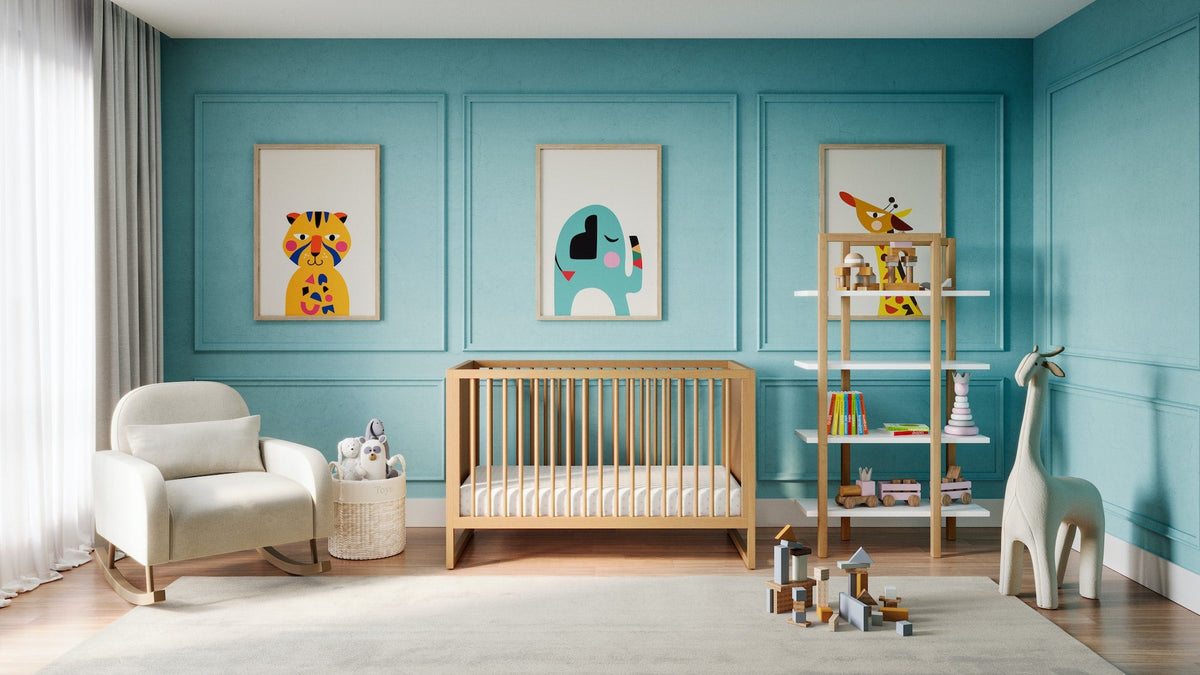
Metal vs. Wood Cribs: Which Is Right for Your Baby
|
|
Time to read 7 min
|
|
Time to read 7 min
In the journey of preparing your nursery for your precious little one, the choice between metal and wood cribs stands as a pivotal decision. It's a choice that intertwines safety, style, and practicality, and it's a choice that reflects your unique preferences and priorities as a parent.
In this guide, we delve into the debate of metal vs. wood cribs, dissecting the features of each option to guide you in making an informed choice. Join us as we help you break down the details and make the right choice for your little one's comfort and security.
When considering whether metal or wood cribs are better, it's crucial to evaluate your priorities. Wood cribs boast classic aesthetics and design versatility, making them ideal for those who prioritize style and a quieter sleeping environment.
On the other hand, metal cribs often excel in terms of durability and modern aesthetics, making them suitable for parents seeking a long-lasting and sleek option. Ultimately, the “better” choice hinges on your unique requirements and preferences.
It's essential to remember that both metal and wood cribs have their strengths:
Wood cribs have an undeniable charm. They exude classic aesthetics and offer design versatility. The warmth and natural beauty of wood can easily complement various nursery decor styles, from traditional to contemporary, while its rich, earthy tones create a cozy and inviting atmosphere.
In contrast, metal cribs often feature a sleek and modern design. They can lend a minimalist and sophisticated touch to your baby's room. If you're looking for a crib that seamlessly fits into a chic, contemporary setting, a metal crib might be the choice for you.

When it comes to durability, metal cribs tend to have the upper hand. They are built to withstand the test of time and are less susceptible to wear and tear. If you're planning on using the crib for multiple children or simply want a long-lasting option, a metal crib could be your best bet.
However, wood cribs, while not as rugged as metal, are certainly no slouch in the durability department. High-quality wood cribs can still provide years of reliable use, especially when maintained properly. Plus, the timeless appeal of wood means it can endure changing nursery decor trends.
One crucial factor to consider is the sleeping environment for your baby. Wood cribs often have an advantage here. The natural properties of wood can contribute to a quieter and more peaceful sleep for your little one. On the other hand, metal cribs can create noise when your baby moves.
In the end, the choice between metal and wood cribs ultimately comes down to your unique requirements and preferences. Are you drawn to the classic charm and design versatility of wood, or do you lean towards the sleek modernity and durability of metal cribs? It's a decision that should align with your personal style and your vision for your baby's nursery.
At Nurture&, we understand the importance of this decision. We offer a wide selection of wood cribs that showcase beauty and durability and offer a completely safe sleep space for your baby.
Wood cribs are a popular choice for many parents due to their timeless appeal and versatility. However, they come with their own set of advantages and disadvantages.
In this section, we will delve into the pros and cons of wood cribs, highlighting why they often emerge as the superior choice for creating the perfect nursery.




Metal cribs are typically heavier than wood cribs, which can make them less convenient to move or adjust within the nursery. This is because metal is a denser material than wood, which means that a metal crib will have more weight relative to its volume than a wooden crib of similar dimensions.
This weight can be a consideration when setting up your baby's sleeping area.
When making the decision between a metal or wood crib, there are several key factors to consider, ensuring the safety, comfort, and style of your nursery. These factors include:
It's paramount to prioritize safety when choosing a crib for your baby. Look for cribs that meet safety standards, such as the Safe Sleep Approved ASTM Safety Standards. Ensuring a secure sleeping environment is a top priority.
Your budget plays a significant role in your crib choice. Determine how much you're willing to invest in your baby's crib and explore options that align with your financial plan.
Consider how the crib will fit into your nursery aesthetics. Both metal and wood cribs offer various design choices, so you can find one that complements your style.
At Nurture&, we understand the importance of these factors when selecting a crib for your baby. Our crib collection is designed to meet your needs and priorities.Our cribs are crafted with sustainably harvested wood and premium materials. We prioritize the use of non-toxic materials to provide a healthy and safe sleeping environment for your baby.
Additionally, many of our cribs offer the versatility of converting into toddler beds, providing value and longevity as your child grows. With three adjustable mattress heights, our cribs are designed for your convenience, allowing easy access to your baby at different stages of development.
Nurture& accompanies you in all stages of your baby's arrival and development, with products made for parents, by parents. Get to know the collection of cribs available, and check out our Journal to find more helpful advise.



